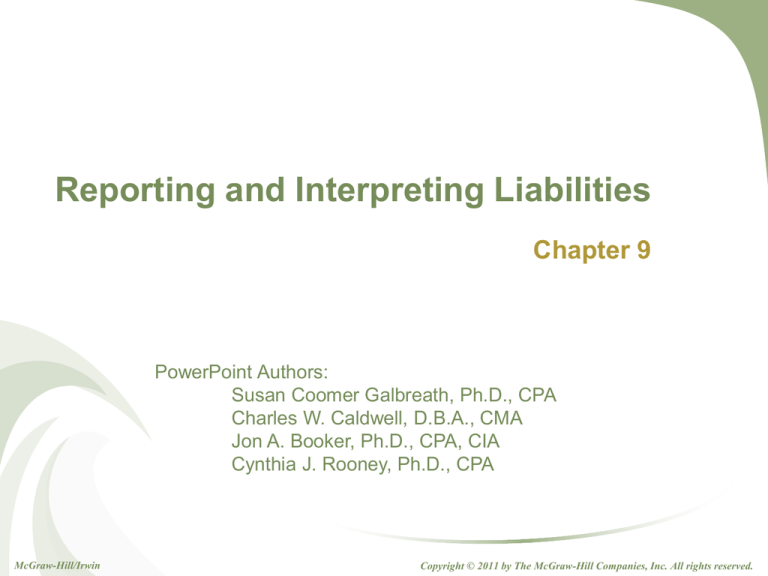
Reporting and Interpreting Liabilities
Chapter 9
PowerPoint Authors:
Susan Coomer Galbreath, Ph.D., CPA
Charles W. Caldwell, D.B.A., CMA
Jon A. Booker, Ph.D., CPA, CIA
Cynthia J. Rooney, Ph.D., CPA
McGraw-Hill/Irwin
Copyright © 2011 by The McGraw-Hill Companies, Inc. All rights reserved.
Liabilities Defined and Classified
Defined as probable debts or obligations of the
entity that result from past transactions, which will
be paid with assets or services.
9-2
Maturity = 1 year or less
Maturity > 1 year
Current
Liabilities
Noncurrent
Liabilities
Current Liabilities
Account
Name
Accounts
Payable
9-3
Also
Called
Trade
Accounts
Payable
Accrued
Liabilities
Accrued
Expenses
Notes
Payable
N/A
Deferred
Revenues
Unearned
Revenues
Definition
Obligations to pay for goods and
services used in the basic operating
activities of the business.
Obligations related to expenses that
have been incurred but have not been
paid at the end of the accounting
period.
Obligations due supported by a formal
written contract.
Obligations arising when cash is
received prior to the related revenue
being earned.
Payroll Taxes
Gross Pay
Net Pay
Less Deductions:
Social
Security
Tax
9-4
Medicare
Tax
Federal
Income Tax
State and
Local Income
Taxes
Voluntary
Deductions
Notes Payable
A note payable specifies the interest
rate associated with the borrowing.
To
the lender, interest is a revenue.
To the borrower, interest is an expense.
Interest = Principal × Interest Rate × Time
9-5
When computing interest for one
year, “Time” equals 1. When the
computation period is less than
one year, then “Time” is a
fraction.
Deferred Revenues
Revenues that have been collected but not
earned.
Deferred revenues are reported as a liability because cash has
been collected but the related revenue has not been earned by
the end of the accounting period.
9-6
Estimated Liabilities
Contingent liabilities are potential liabilities that are
created as a result of a past event.
Subject to estimate
Not subject to estimate
Probable
Record as liability
Disclose in note
Reasonably Possible
Remote
Disclose in note
Disclosure not required
Disclose in note
Disclosure not required
The probabilities of occurrence are defined in the following manner:
1. Probable—the chance that the future event or events will
occur is high.
2. Reasonably possible—the chance that the future event or
events will occur is more than remote but less than likely.
3. Remote—the chance that the future event or events will
occur is slight.
9-7
Long-Term Liabilities
Creditors often require the borrower to
pledge specific assets as security for
the long-term liability.
9-8
Maturity = 1 year or less
Maturity > 1 year
Current
Liabilities
Noncurrent
Liabilities
Lease Liabilities
Operating Lease
Capital
Lease
Short-term lease; No
liability or asset
recorded
Long-term lease; Meets
one of 4 criteria; Results
in recording an asset
and a liability
Capital Lease Criteria
1. Lease term is 75% or more of the asset’s expected economic life.
2. Ownership of the asset is transferred to the lessee at the end of the lease.
3. Lease permits lessee to purchase the asset at a price that is lower than its fair
market value.
4. The present value of the lease payments is 90% or more of the fair market value
of the asset when the lease is signed.
9-9
Present Value of a Single Amount
The present value of a single amount is
the worth to you today of receiving that
amount some time in the future.
Present
Value
Future
Value
Interest compounding periods
Today
9-10
Future
Present Values of an Annuity
An annuity is a series of
consecutive equal periodic
payments.
Today
9-11
Present Values of an Annuity
What is the value today of a series of
payments to be received or paid out in
the future?
Payment 1
Present
Value
Today
9-12
Payment 2
Interest compounding periods
Payment 3
Future Value of an Annuity
• Equal payments are made each period.
• The payments and interest accumulate over time.
Payment 1
Payment 2
Interest compounding periods
Today
9-13
Payment 3
End of Chapter 9
9-14






